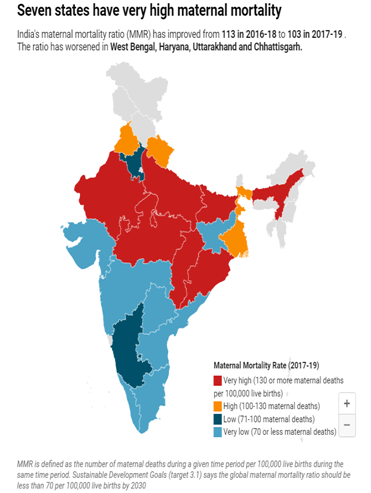

21th July 2022 (7 Topics)
Context
A recent study published in PLOS Global Public Health journal casts a shadow over the progress of health care targeting women in the country.
It also questioned the reliability of the country’s own periodic estimates of maternal mortality ratio, or MMR.
About
About the study
India is going to celebrate the 75th anniversary of Independence but still so many districts show a very high MMR.
- It clearly indicates that there is inadequacy of responsiveness of health systems.
- Maternal Health is analysed by access to contraceptives, antenatal care, post-delivery health care, body mass index, and the economic status.
- However India’s policies are concerted to reduce higher-order births and births in higher ages.
- India’s focus now should be to improve overall care for women, and keep real time track of such crucial health data.
- Immediate action is required to meet the SDG goal regarding
Key Points
- Researchers from the International Institute for Population Sciences used data from routine records of maternal deaths under the Health Management Information System, with Census data and the Sample Registration System (SRS) to provide the MMR for all States and districts of India.
- State-wise disparities have been observed.
- The analysis suggests that 70% of districts (448 out of 640 districts) in India have reported MMR above 70 deaths.
- Many of the districts in southern India and Maharashtra have an MMR of less than 70.
- At the same time, the north-eastern and central regions have the least number of districts (12 and six districts, respectively) with an MMR less than 70.
- Significantly, it also demonstrates the presence of huge within-State inequalities, even among the better performers — Karnataka, Tamil Nadu, Kerala, Andhra Pradesh, and Telangana.
- According to the SRS (2016-18), only Assam (215) has an MMR of less than 200, while in this district-level assessment, the indications are that about 130 districts have reported above 200 MMR.
How the Maternal Mortality is calculated in India?
- In India, the number of deaths caused due to pregnancy and childbirth has been very high over the years but recent records show that there has been a decline in the MMR of India.
- It is tough to calculate the exact maternal mortality except where the comprehensive records of deaths and causes of death are available.
- So surveys and census are used to estimate the levels of maternal mortality.
- Reproductive Age Mortality Studies (RAMOS) is presently considered the best way to calculate MMR.
- In this, different sources and records are analysed to get data regarding the death of women of reproductive ages and also through verbal autopsy to estimate the number of deaths.
- The MMR is calculated at both global and regional level every five years through a regression model.
- The Sample Registration Survey (SRS) is used to get an estimate of the maternal mortality rate.
- The Office of the Registrar General’s Sample Registration System (SRS) had last released a special bulletin on Maternal Mortality in India in March 2022.

|
Some Government Interventions
|
More Articles


